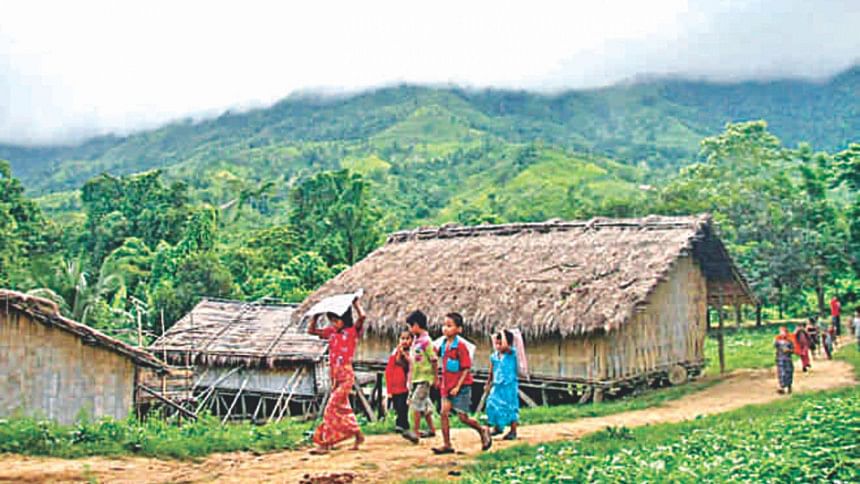Don't forget the CHT

CHITTAGONG Hill Tracts (CHT) has been one of the most underdeveloped, deprived and backward areas of Bangladesh. Home of 'small ethnic entities' – as described by the Constitution of Bangladesh - the standard of living of the CHT population is still a matter of grave concern despite notable positive initiatives taken by the government and donor agencies under the Peace Accord.
According to General Economics Division (2015), the incidence of absolute poverty among ethnic minorities is 89 percent while extreme poverty accounts for 78 percent. The CHT continues to lag behind in terms of basic human needs, health and nutrition, social security, access to improved water and sanitation, physical infrastructure, employment, and economic and social empowerment compared to other regions of the country.
Public expenditure is widely considered as a strong instrument for socio-economic development and empowerment of any backward region. The theory of distributive justice implies that the lagging regions should receive higher weight in the public spending in order to achieve greater equity. Thus, CHT is expected to receive special and differential treatment in the upcoming budget, which is also committed to the Peace Accord, Sixth Five-Year Plan, Perspective Pan and social sector policies in Bangladesh.
The Ministry of Chittagong Hill Tracts Affairs (MoCHTA) was established as a specialised ministry to look after the major administrative affairs of the CHT issues and to implement major development projects in the backdrop of realising commitments of the landmark Peace Accord. The total budget of MoCHTA was Tk.735 crore in the fiscal year 2014-15, of which the non-development and development budget was Tk 259 crore and Tk 476 crore respectively. The majority of the ministry's budget belongs to the Secretariat; the rest is distributed among the Development Board, and Regional Council. The Ministry implements a total of four development projects.
Budget allocation and spending for non-elected bodies is higher than the same for elected bodies. Here, elected bodies are the Hill District Parishads and Regional Council, and the Development Board is a non-elected body. The national budget witnessed a positive growth in the last four years ranging from 16 percent to 24 percent, while it was negative to only about two percent in MoCHTA. General Social Safety Net Programmes (SSNPs) such as allowances, food transfer, conditional grants and loans are applicable for CHT areas. The special needs of this region are yet to be conceived and reflected in the SSNP budget.
Less than one percent has been allocated in the current fiscal year's budget in only two projects. The larger portion of this money was allocated to the project titled Food Assistance in CHT Area. The rest is allocated to the Integrated Community Development Project that focuses on child protection. Thus, there is a general paucity of social protection programmes. Even the recent National Social Security Strategy (2015) does not have any clear commitment to initiating special programmes for the CHT. The Ministry of Education undertook a great initiative by establishing the Science and Technological University at Rangamati. Some other projects have been initiated by the said ministry and the Ministries of Cultural Affairs, Agriculture, and Fisheries and Animal Resources. However, the budget allocation of these projects is relatively insignificant and inconsistent.
The end-year rate of execution of ADP for CHT has been found to be satisfactory and consistent with the national rate of execution. However, the spending suffers from the 'fourth quarter syndrome', i.e. most of the ADP projects are executed in the final quarter of the fiscal year. IMED data reveals that only 41 percent of the ADP of MoCHTA was executed in the first nine months of the outgoing fiscal year. It is lower than the rate of execution of total ADP (43 percent).
The CHT region is expected to receive special budgetary measures given the pledges made in the national plan and policy documents as well given the higher needs of the districts. Per capita ADP in this area should also be higher than the national per capita since the CHT is not a very densely populated area. However, the per capita ADP for CHT region is persistently lower than that of the national per capita from 2010-11 to 2014-15. In addition, there is a trend of acute divergence between the two, which means that there is a serious need for initiating special development projects in line with the pledges that would help ensure development of the region that is consistent with the national average.
The last three consecutive budget speeches had witnessed a declining number of commitments toward issues concerning the CHT region. The upcoming budget has been more or less prepared and if news reports are to be believed, there seems to be little indication that the persistently pressing demands of the CHT region will be addressed in this year's budget. Finance and Planning ministers are yet to make any major commitment regarding CHT in pre-budget occasions. However, since the budget speech has yet not been prepared, commitments can be explicitly made in introducing a National Language Policy to promote service provisions including education, health and legal services, implementation of the pledge regarding land dispute through reinstituting land commission and introducing an appropriate land policy. These would uplift the face of the upcoming budget as being friendly to the fundamental issues of the CHT region.
The writer is Senior Research Fellow at the Bangladesh Institute of International and Strategic Studies (BIISS).
E-mail: [email protected].

 For all latest news, follow The Daily Star's Google News channel.
For all latest news, follow The Daily Star's Google News channel. 



Comments